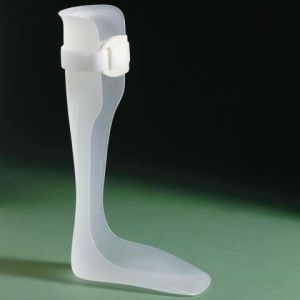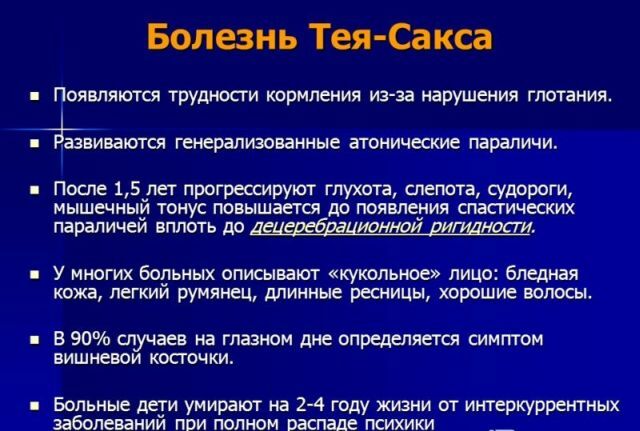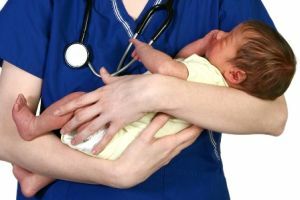 Duchene-Erba paralysis is a paralysis of the hand that occurs as a result of injury or trauma to the upper brachial shaft of the nerve plexus.
Duchene-Erba paralysis is a paralysis of the hand that occurs as a result of injury or trauma to the upper brachial shaft of the nerve plexus.
Such a pathology can occur in infants due to the resulting birth trauma when pulling the head, limb or pelvis of the fetus.
Pathogenesis of
disorder Due to trauma, a rupture, tearing, tension of the trunk of the brachial plexus, and damage to the stair muscles with possible bleeding can occur.
After some time in the field of the nerve plexus of the brachial column, scarring forms, which causes a repeated squeezing of the plexus. In this case, the non-conductivity of the nerves develops, which is fraught with consequences such as a violation of blood circulation and the formation of neurin inside the trunk.
This pathology is a disease characterized by three stages:
- 1 stage - acute period, lasts up to one month from the moment of birth;
- 2 stage - rehabilitation period, lasts up to a year;
- Stage 3 - residual events, begins with a one-year-old child.
Birth paralysis derives its name in honor of the German neuropathologists G. Duchene and W. Erba at the end of the XIX century. They made a discovery that showed that during the manipulation at the time of delivery, shoulder muscles that are innervated from the 5th and 6th cervical segments of the spinal cord are affected, resulting in the development of upper paralysis.
This pathology is a fairly common type of traumatic injury that a baby can get during childbirth. The frequency of cases occurs in about 1-2 newborns per 1000 people.
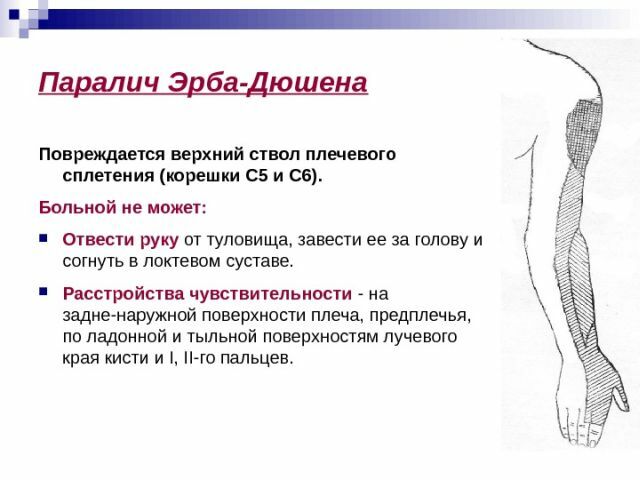
Aggravating factors
The main risk factors that can trigger the occurrence of this disorder are: 
- the child's greater weight is more than 4 kg;
- weak labor activity, narrow female pelvis;
- the nature of the presentation of the fetus;
- severe prolonged labor, at the time of which various auxiliary methods and techniques are used - the use of special forceps, the release of the fetus by the leg, the handle, the pelvis.
As a result of such actions, the axillary nerve is often damaged, branching from the posterior fascicle, which is located in the brachial plexus. Along with this, a disturbance of the function of the suprathinic nerve can also be detected.
Features of clinical picture
Symptomatic pathology will depend on the severity of damage to nerve fibers and conduction disorders of nerve impulses.
In children with this disorder, manifestations of paralysis are clearly visible. First of all, there will be noticeable constant anxiety due to painfulness of the resulting injury. Also among the main symptoms can be identified:
- reduction in muscle tone;
- inflexibility of the handle in the elbow joint;
- the damaged arm turns out unnaturally;
- breathing is weak;
- the fist of the injured hand contracts with the thumb thumb;
- the skin on the hand can turn pale and turn cold;
- pressing the injured hand to the body;
- no response to stimuli.
Despite the fact that the damaged arm becomes practically inactive, the joint of the hand and fingers perform movements of low intensity.
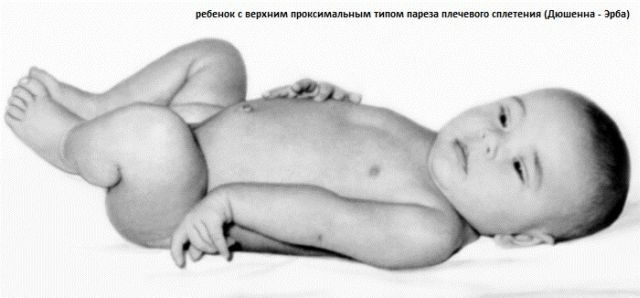
In the photo a child with Duchene Erb's paralysis
Aims and methods of diagnosis
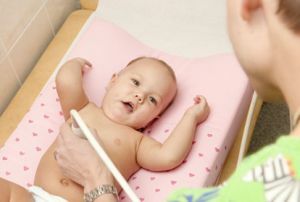 If there are signs of pathology, a consultation with a neurologist and orthopedist is carried out.
If there are signs of pathology, a consultation with a neurologist and orthopedist is carried out.
To confirm the diagnosis, the specialist collects an anamnesis and examines the injured limb.
In order to obtain additional necessary information, diagnostic procedures are performed:
- electroneuromyography;
- rheovaseography;
- MRI;
- CT;
- X-ray;
- dynamometry;
- electromyography;
- ultrasound - examination of the shoulder joint;
- ultrasound - examination of the cervical vertebral column.
Symptomatic of Duchesne-Erb's syndrome is very unambiguous, In this regard, the formulation of an accurate diagnosis does not cause any difficulties.
And yet in this case, a complete examination is simply necessary in order to make the most accurate prognosis of the course of the disease and to select the most effective methods of treatment.
Medical assistance
Treatment of the Duchesne-Erba paresis is carried out in stages and begins immediately from the first days of the baby's life. Therapy will be carried out for a long time using various methods:
- In the acute form of the pathology, is performed by immobilization of the injured arm of the and the shoulder joint by the imposition of a tire. Sometimes, if a displacement of the structures of the shoulder joint is detected, the immobilization of the damaged shoulder can be used for a whole year. The tire will be removed only for the purpose of performing hygienic and therapeutic procedures. In extremely severe cases, the use of a tire can be prescribed for even a few years.
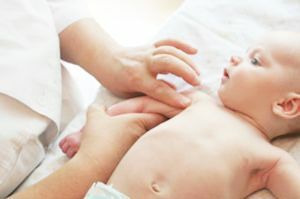
- In order to maintain muscle tone, the course of manual therapy and special physical training is necessary.
- If the baby does not show any improvement in arm performance, surgical treatment of may be prescribed. After this, the child needs a long rehabilitation, which implies the passage of a course of special physical therapy, manual therapy and reflexology. Very often the patient is shown acupuncture and the procedure of muscular electrical stimulation.
- The medication plays a very important role in therapy. In this case, vitamin complexes with a high concentration of vitamin B are prescribed for use. Analgesics, salicylates, promedol, and amidopyrine are also prescribed.
- If infection occurs, the antibiotic treatment is prescribed. In addition, in some cases, the use of anesthetic ointments.
In most cases, in children with this pathology, with adequate treatment, the full recovery of the  motor function occurs in the first year of life. In this case, the expert removes the diagnosis.
motor function occurs in the first year of life. In this case, the expert removes the diagnosis.
However, the danger is that after a few years, relapse of the disease may occur, for example, a shortening of the damaged limb due to underdevelopment will be noted. In this case, the continuation of treatment is often carried out with the operation.
If surgical treatment is required for a child under 3 years of age, arthroscopy is performed. This method is a minimally invasive operation and is performed using an optical fiber. Such an operation is favorably tolerated by the baby's body and, with a properly selected subsequent recovery course, leads to very successful results.
Complications and prognosis
Dushen-Erba obstructive paralysis, even with proper therapy and rehabilitation, may still have certain consequences that are characterized by such symptoms:
- Over time, may develop shortening and the dystrophy of the hand .
- In addition, the underdevelopment of the blade is detected, which manifests itself in its reduced size and asymmetric
 location.
location. - Because of the injury and as a result - damage to the nerve fibers of the brachial plexus, symptoms of the scoliosis , which mainly affects the cervical and thoracic spine, are often found.
- Despite the fact that in more than half of cases it is possible to achieve positive results, some children develop decrease in muscle strength relative to a healthy arm .
- Also in practice, there have been cases when a severe lesion of the brachial plexus was accompanied by a minor narrowing of the eye on the side of the injured limb .However, this effect was rapid enough with correct and timely therapy.
Duchesne-Erba paralysis is a very serious trauma, and in order to avoid serious complications, it is extremely important to begin therapy immediately after the onset of the baby. Thanks to this over time, the function of the damaged arm is restored, and the child can live a full life.
Prevention of this birth injury is the proper management of pregnancy and childbirth, the appropriate choice of the method of delivery, due to which the risk of injury to the child will be minimized.


